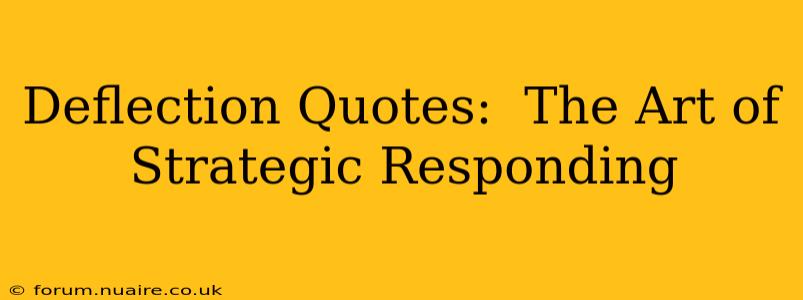Deflection, in its purest form, is the skillful redirection of attention or criticism away from oneself. It's a subtle art, a nuanced tactic often employed in communication, negotiation, and even conflict resolution. Mastering the art of deflection can be invaluable in navigating challenging interpersonal situations and maintaining composure under pressure. This isn't about lying or avoiding accountability; rather, it's about strategically managing the flow of conversation to achieve a desired outcome. This article explores deflection quotes, showcasing their power and examining how they can be strategically employed.
What is a Deflection Quote?
A deflection quote is any statement used to subtly shift the focus from a sensitive or uncomfortable topic to a more neutral or advantageous one. It's not about escaping the issue entirely; it's about re-framing the conversation, buying time, or diffusing tension. These quotes often employ humor, empathy, or a change of subject to achieve their objective. Effective deflection requires finesse; a poorly executed deflection can appear evasive or dishonest.
Types of Deflection Quotes and Strategies
Several strategies underpin effective deflection quotes. Let's explore some common approaches:
1. Acknowledging and Reframing
This approach involves acknowledging the initial point but immediately shifting the focus. For example, responding to criticism with, "I understand your concern, and I appreciate you bringing it to my attention. However, let's focus on..." skillfully redirects the conversation.
2. Using Humor
Humor can diffuse tense situations and subtly shift the conversation's tone. A well-placed joke or witty remark can disarm a critic and redirect attention away from the original point of contention. This requires careful judgment, as inappropriate humor can backfire.
3. Emphasizing Shared Goals
Highlighting common ground and shared objectives can create a collaborative atmosphere. This approach redirects the conversation towards cooperation rather than confrontation. For example, "I agree that this is a challenge, and I'm committed to finding a solution that works for both of us."
4. Asking Clarifying Questions
Asking thoughtful questions about the criticism itself can create a space for reflection and a chance to reframe the conversation. This tactic buys time and allows for a more considered response.
5. Shifting the Focus to a Broader Context
Placing the issue within a larger context can minimize its significance. For instance, responding to a complaint about a minor detail with, "While that's a valid point, let's remember the bigger picture here..." puts the issue in perspective.
Examples of Deflection Quotes in Action
- "That's an interesting perspective. Have you considered...?" This quote acknowledges the other person's point while immediately pivoting to a different aspect of the issue.
- "I appreciate your feedback. Let's talk about how we can move forward." This redirects the focus from blame to solutions.
- "That's a fair point, but I think the more pressing issue is..." This acknowledges the validity of the initial concern while prioritizing a different matter.
- "I can see why you feel that way. However, let's look at this from a different angle." This shows empathy while shifting the perspective.
How to Use Deflection Quotes Effectively
The key to effective deflection lies in sincerity and timing. A forced or disingenuous deflection will be easily detected. Here are some tips for successful implementation:
- Be genuine: Your deflection should feel natural and authentic.
- Choose the right moment: Don't deflect constantly; use it strategically in appropriate situations.
- Be mindful of your tone: Your tone of voice should reflect empathy and understanding.
- Don't avoid accountability: While deflection can be useful, it shouldn't be used to avoid taking responsibility for your actions.
Is Deflection Ever Unethical?
Deflection becomes unethical when it's used to deceive, manipulate, or avoid legitimate accountability. Honest and genuine deflection, however, is a valuable communication tool. The ethical line lies in intent.
Frequently Asked Questions
What are some examples of bad deflection techniques?
Bad deflection techniques include ignoring the question, changing the subject abruptly without acknowledging the original point, or becoming defensive and aggressive. These strategies can damage trust and escalate conflict.
How do I know when to deflect and when to address the issue directly?
Consider the severity of the issue, your relationship with the other person, and the overall context. If the issue is minor or the situation is tense, deflection might be a good tactic. However, for significant issues requiring accountability, direct address is necessary.
Can deflection be used in a professional setting?
Yes, deflection can be a useful tool in professional settings, particularly in negotiations or conflict resolution. However, it should be used judiciously and ethically.
Is deflection a form of manipulation?
Not necessarily. While it can be used manipulatively, deflection is primarily a communication strategy. Its ethical implications depend heavily on the intent and execution.
Mastering the art of deflection requires practice and self-awareness. By understanding its nuances and ethical considerations, you can leverage its power to navigate challenging conversations with grace and effectiveness.

